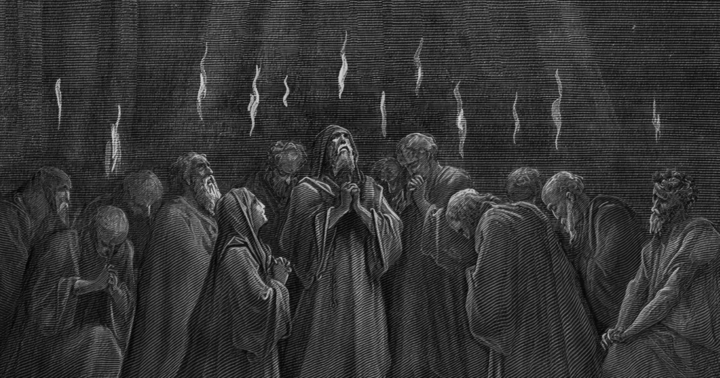This year is the 1,700th anniversary of the Council of Nicaea. Here we invite a writer to reflect on articles of the Nicene and Apostles' Creed:
When we were students, my wife Denise and I used to attend Mass at Blackfriars, where we could listen to sermons delivered by some of the most renowned and brilliant Catholic thinkers and speakers. Timothy Radcliffe and Herbert McCabe were on the rota. I'm sure they were all brilliant but the only sermon either of us actually remember was one delivered on the feast of All Saints by a new, young priest.
It was a hilarious, knock-about piece about the wild, eccentric varieties of religious experience. Held together by a series of terrible puns (Simeon Stylites lived on top of a pole, and talking of Poles …), it was way out of line with the lofty wisdom we normally got.
As he put it, "St Lawrence was roasted alive, as I shall probably be when I walk into the refectory after this." The young priest was Malcolm McMahon. His sermon stayed with me so vividly that it provided part of the inspiration for a book and a film that I wrote called Millions, about a boy who is visited by saints ranging from Clare of Assisi to the martyrs of Uganda and St Peter himself.
When Malcolm became Archbishop of Liverpool, I got the chance to thank him and he gave me a copy of that sermon. The names of saints are everywhere. On our towns, schools, hospital, railway stations, underwear, even nervous disorders.
But their stories are often forgotten. We talk as if canonised saints were just better, more courageous versions of ourselves, but flick through a dictionary of saints and you will find some fierce and eccentric ways to love God.
Whether it's St Kevin holding the blackbird's nest in his hands until the eggs are "hatched and fledged and flown" or St Lidwina who could apparently live without sleep. Wilgefortis avoided forced marriage by growing a beard. I'm always encouraged by the example of St Pyr, an abbot who fell down a well when drunk and was canonised as a result of clerical error. He's the patron of Caldey Island, a small and blameless portfolio.
There is hardly an inhabited place or a human activity that has not been trusted to the care of a saint. Lawrence, for instance, is the patron of comedians because while being roasted alive he famously wisecracked that he was well done on this side and that they should turn him over.
People are often taken aback that there's a patron saint of television (St Clare) and one for the internet (Isidore of Seville – he must be kept busy). Because I don't have any myself, I was unaware until recently that St Clothilde was the patron of disappointing children. And anyone who knows their 19th-century novels is aware the patron of cabbies is Fiacre.
The Catholic Faith is often seen as highly centralised and dogmatic but the panoply of saints celebrates the many ways we can live truth. You can be an intellectual giant and public figure like Aquinas or Catherine of Sienna, a "dirty and difficult" man of action like Damien of Molokai, or a bewildered mountain teenager like St Bernadette.
If it's diversity you're after – whether of race, class or mentality – the piety stall is the place to look. The statues of saints that you'll find in that piety stall are condensed stories, like movie trailers. Young woman with a cartwheel? That will be Katherine of Alexandria (patron of fireworks). Chap with three money bags? St Nicholas (patron of pawnbrokers as well as Christmas). Young woman holding her own severed breasts on a tray? St Agatha (patron – thanks to visual confusion – of bell makers). The feast of St Agatha is commemorated by the bakers of Catania by the making of some embarrassingly mammary cakes.
Feast days are another of the ways in which this vast heritage is kept alive. Take a minute to appreciate how extraordinary it is that hundreds of years after their deaths, people like St Patrick or St Anthony still provide the pretext for street parties and community get-togethers. Does any field of knowledge offer such a combination of the arcane and the accessible? Is any invitation so open and inviting?
In the book of Millions, the child narrator's mother, Maureen, has recently died. Throughout the story, he questions the saints of his visions for news of her whereabouts. The film ends with him finally encountering his mother now St Maureen who promises that she will be with him always.
The real power of that phrase "the communion of saints" surely comes in that word "communion", that sense that they – those who have gone before us marked with the sign of faith – are all one. Yes, that we will meet again, as Thomas More (patron saint of lawyers and large families) said, "merrily in Heaven".
But more immediately and profoundly that we meet beyond the laws of past and future, life and death, we meet eternally in communion.
Photo: graphic by Arcadia
This article appears in the October/November2025 edition of the Catholic Herald. To subscribe to our thought-provoking magazine and have independent, high-calibre and counter-cultural Catholic journalism delivered to your door any where in the world click HERE.







.jpg)

.jpg)






